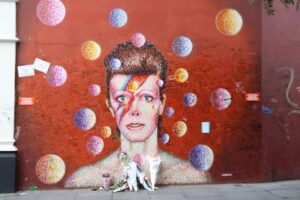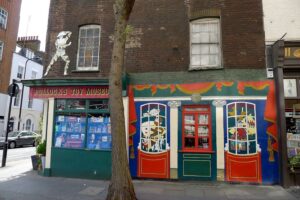The Spots Around London That Make Up David Bowie’s Life
Date post added: 23rd March 2023

Image by Ron Frazier
If the remarkable rock star, David Bowie, is one of your heroes, then you must visit the most significant places in his London life. Here, we share 10 landmarks in David Bowie’s London.
From humble beginnings in Brixton, Bowie forged his early career in Soho before being propelled to huge fame. Throughout his career, he lived across the world in New York (from Soho, London to Soho, Manhattan), LA, Mustique and Lausanne, Switzerland. But he was a Londoner and designed a home in Chelsea in his later years which he never actually lived in.
You can follow in Bowie’s footsteps and hear some of the fascinating stories of Bowie’s 60s London with our guided walk. But for now, this blog will give you our top 10 highlights.
1. 40 Stansfield Road, Brixton
Before he was a superstar or even a starman, David was plain old David Robert Jones. His parents were Peggy and John and they all lived together at this Brixton address. 40 Stansfield Road SW9 was his childhood home until he moved to Bromley, Kent, aged 6.
Around the corner from here, you’ll find Stockwell Primary School where he started his education. Even at that young age, he displayed a certain defiance.
2. David Bowie mural, Brixton
On the wall of Brixton Road, right on the side of Morley’s department store is a wonderful homage to one of Brixton’s most famous residents. It’s just across the road from Brixton tube station giving a colourful welcome to the neighbourhood.
The bold, bright mural was created by street artist James Cochran in 2013. Bowie’s face is emblazoned with the iconic lightning bolt makeup from his Aladdin Sane album cover. Since his death, it’s become a place for his fans to lay tributes and pay their respects.
3. High Street, Beckenham
It’s not technically London, but Beckenham is just across the South East London border in Kent and down the road from Bromley. David spent many of his formative years here and that’s commemorated by a plaque.
It was here, on the high street, that he set up a folk club, Beckenham Arts Lab in 1969. Back then, when he was launching his music career, it was The Three Tuns pub. Now, it’s the chain restaurant Zizzi’s, still complete with the commemorative plaque.
4. Denmark Street, Soho
Onto the Soho, London chapter of Bowie’s life and emerging music career. Picture the young David Bowie with long hair and cutting-edge 60s fashion, sauntering along Denmark Street. It was rife with music shops displaying Fender guitars and the latest keyboards which he doubtless peered into regularly.
It was here that he’d hang out with his glam rocker friend, Marc Feld, better known to us as Marc Bolan. La Gioconda Café was their hangout of choice and sadly, it is no more. It was next door at number 7 that Bowie met his first agent.
5. Decca Studios, Broadhurst Gardens NW6
In Decca Studios, David Bowie recorded his first self-titled, album – David Bowie. That was in 1966/67. A few years earlier in 1962, Decca had turned down The Beatles. They weren’t going to let another rising phenomenon slip through their fingers.
Bowie wanted to push boundaries and sought originality in sound and in vision. He didn’t stick with Decca indefinitely, bouncing to Columbia and then Pye record labels.
6. 39 Manchester Street, W1U
It was at this early stage of his career in the late 60s that he lived in Marylebone. Number 39 Manchester Street was his home from 1967-68. He lodged with his then manager, David Pitt.
From here, he’d make frequent visits to the Wallace Collection on Manchester Square. Its art collection formed part of Bowie’s cultural study and helped to fuel his creativity and vision.
7. Pollocks Toy Museum, Scala Street W1T
This was said to have been a favourite shop of David Bowie when he lived near Manchester Square in Fitzrovia. He was fascinated by the Victorian prints and slightly creepy-looking clowns and theatre dolls. It was another place that fuelled his creative imagination. He’d surround himself with the curious, colourful and somewhat strange knick-knacks and pieces of art. It’s said to have been a major influence on his experimental style.
8 Heddon Street, W1
Tucked away down an innocuous-looking Mayfair alleyway is an important landmark in Bowie’s London tour. A plaque on the wall there says ‘This marks the location for the cover photograph for the iconic David Bowie album, The Rise and Fall of Ziggy Stardust and the Spiders From Mars – Ziggy Stardust 1972.’ That memorable album cover was the first appearance of Ziggy Stardust, Bowie’s alter-ego.
9 Trident Studios, St Anne’s Court, W1
In the heart of Soho, between Dean Street and Wardour Street, is another alleyway that formed part of Bowie’s story – St Anne’s Court.
In the late 60s, Trident was a forward-thinking studio boasting the first 8-track recording facility. Space Oddity, Hunky Dory, Changes, Life on Mars and The Rise and Fall of Ziggy Stardust – so many classic tracks were laid down here.
Before it closed down in 1984, the studio worked with the likes of The Beatles, Elton John and Queen.
10. V&A East
Ok, so now we’re future-gazing. But from 2025, The David Bowie Centre for the Study of Performing Arts will be open. The dedicated space at the new V&A East Storehouse in Stratford will house an exhibition of the Bowie archive including “a series of intimate notebooks from every era of Bowie’s life and career,” a V&A statement says. Expect to see costumes, albums, lyrics and videos from across the rock star’s life and career.
If we’ve whet your appetite for discovering more about Bowie’s life in London, don’t miss Adam’s Bowie’s 60s London walk. As our customer Morgan from Texas said: “It’s like having your own personal rock star for a tour guide”. Otherwise, choose from our available Rock N’ Roll tours.




